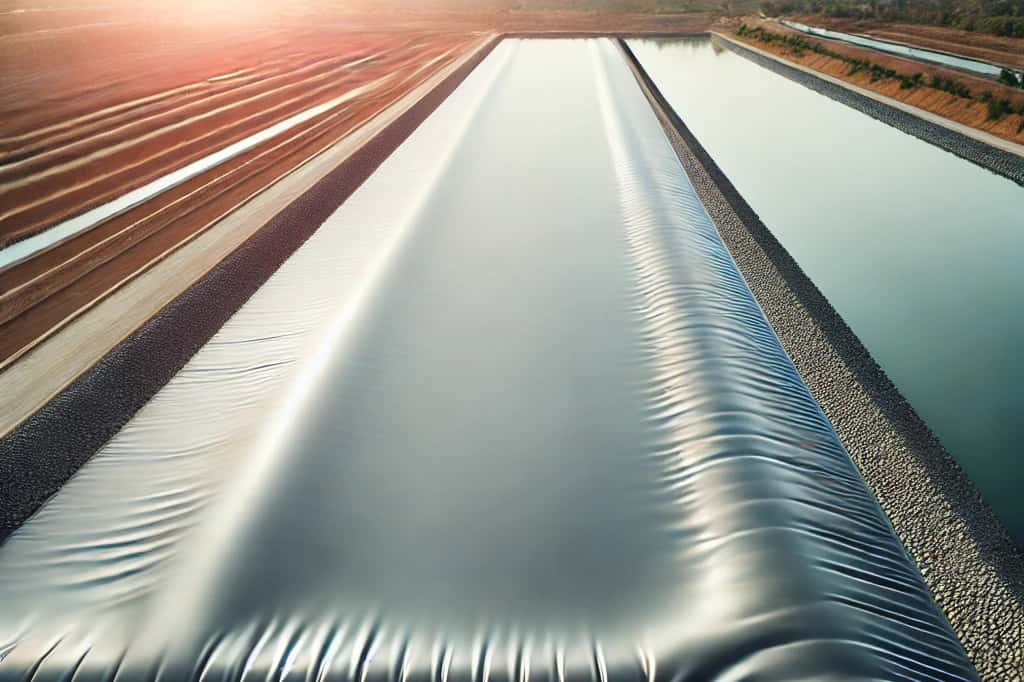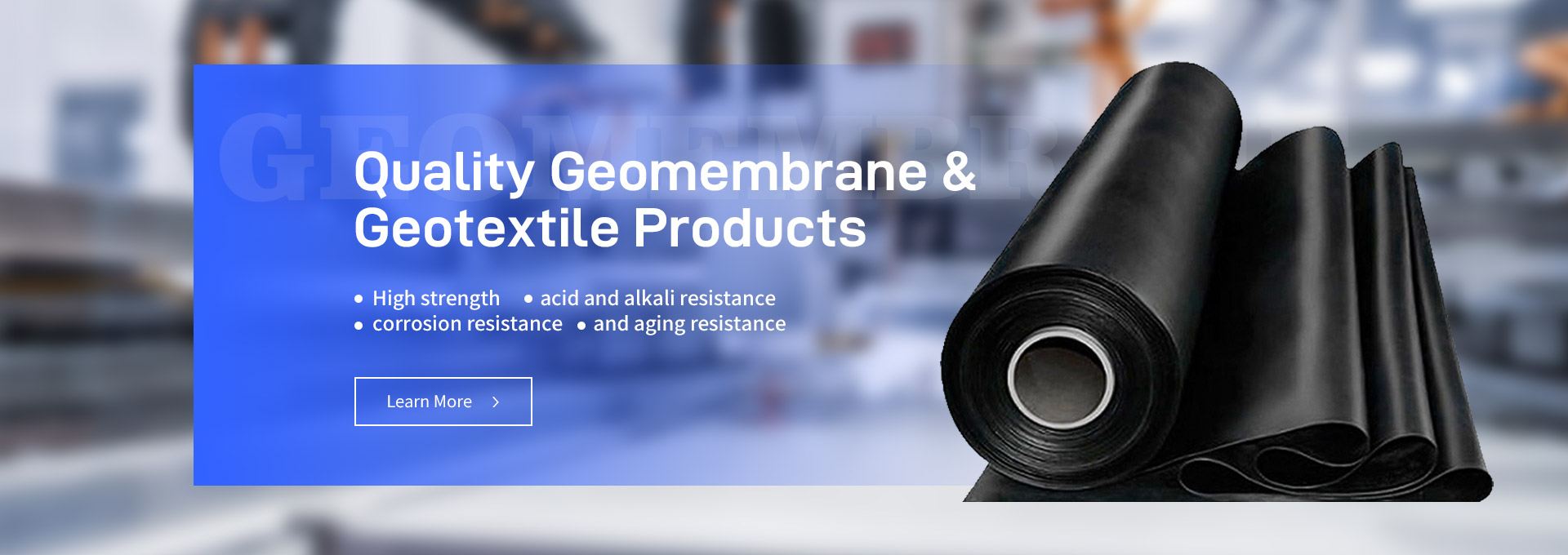Geomembrane is a synthetic membrane liner or barrier used in various industries to control fluid or gas migration in man-made projects, structures, or systems. These membranes are typically made from polymeric materials and are widely used for their durability, impermeability, and chemical resistance. They serve as a fundamental component in a wide array of applications, ranging from waste management and water conservation to mining and construction.

The Basics of Geomembrane
At its core, a Geomembrane is a continuous, thin sheet of material designed to act as a barrier to liquids or gases. The primary role of a Geomembrane is to prevent fluid migration, which is critical in many engineering projects. Whether it's to contain hazardous waste in a landfill, prevent water seepage in a pond, or line reservoirs, Geomembrane plays a vital role in ensuring the integrity of a structure or system.
Materials Used in Geomembranes
Geomembranes are typically made from various polymeric materials, each chosen for specific properties such as flexibility, strength, and resistance to chemical degradation. The most common materials include:
High-Density Polyethylene (HDPE): Known for its strength and high chemical resistance, HDPE is one of the most widely used materials for Geomembrane liners.
Low-Density Polyethylene (LDPE): More flexible than HDPE, this material is used when adaptability to irregular surfaces is important.
Polyvinyl Chloride (PVC): PVC offers flexibility and ease of installation, often chosen for smaller or less demanding applications.
Ethylene Propylene Diene Monomer (EPDM): A synthetic rubber membrane known for its flexibility and UV resistance, used in roofing and pond linings.
The choice of material depends on the specific application, environmental conditions, and performance requirements.
Types of Geomembranes
There are several types of Geomembrane based on the texture and surface characteristics:
1.Smooth Geomembrane:
As the name suggests, a Smooth Geomembrane has a smooth surface on both sides. This type is widely used in applications where maximum contact with the substrate is essential, such as lining for ponds, reservoirs, and canals. Its smooth surface allows for easier installation and better conformity to the surface it's applied to. The smooth finish also minimizes friction, making it a preferred choice when overlapping and sealing the membrane.
2.Textured Geomembrane:
This type has a rough surface, providing higher friction angles for use in slopes or steep terrain. It's ideal for applications requiring a firm grip on the subgrade, such as landfill liners on steep inclines.
3.Waterproof Membrane:
A Waterproof Membrane is a specific type of Geomembrane designed explicitly for water-retaining structures. It is commonly used in roofing systems, underground structures, tunnels, and water tanks. The Waterproof Membrane is crucial in preventing water leakage and protecting infrastructure from water damage.
Properties and Benefits of Geomembrane
1.Impermeability
The primary function of a Geomembrane is its impermeability. It acts as a barrier to water, chemicals, gases, and even small particles, making it essential in environmental protection, particularly in landfills, ponds, and canals. In these settings, a Geomembrane prevents contaminants from leaking into the groundwater or surrounding environment.
2.Durability and Resistance
Geomembrane liners are highly durable and can withstand extreme weather conditions, UV radiation, and chemical exposure. This makes them ideal for outdoor applications such as mining and agricultural reservoirs. Their chemical resistance ensures that they are not degraded by the substances they are meant to contain, such as waste materials or hazardous chemicals.
3.Flexibility
In certain applications, the Geomembrane must adapt to irregular surfaces or changing environmental conditions. Materials like Smooth Geomembrane offer the flexibility needed to handle uneven terrain while still providing a reliable seal.
4.Cost-Effectiveness
Compared to traditional concrete or clay liners, Geomembrane liners are generally more cost-effective. They require less material, are quicker to install, and provide a longer-lasting solution. This helps to reduce both initial construction costs and long-term maintenance expenses.
Applications of Geomembrane
1.Waste Management
One of the most critical applications of Geomembrane is in waste management. Landfills use Geomembrane liners to create a barrier between the waste material and the surrounding soil and water. This prevents hazardous chemicals from leaching into the ground and contaminating the water supply. A typical landfill uses both a Smooth Geomembrane and a textured Geomembrane liner to ensure maximum containment and stability.
2.Water Conservation
In the agricultural sector, Geomembrane liners are used to line irrigation ponds, canals, and reservoirs to prevent water loss. In arid regions, water is a precious resource, and even small leaks can lead to significant wastage. Using a Waterproof Membrane ensures that the water stays contained, reducing evaporation and seepage losses. These membranes also help to protect the water from contamination by soil or other impurities.
3.Mining
Mining operations require the containment of large volumes of water and chemicals. Geomembrane liners are used to line tailings ponds and heap leach pads to prevent hazardous materials from escaping into the environment. In this context, the chemical resistance of materials like HDPE is vital to ensure the long-term integrity of the system.
4.Construction
In the construction industry, Waterproof Membrane is used to protect buildings and underground structures from water infiltration. These membranes are commonly applied in basements, tunnels, and foundation systems to provide a waterproof barrier. They help prevent water damage, which can lead to costly repairs and structural issues over time.
5.Environmental Protection
In projects where environmental protection is a priority, such as in wildlife reserves or natural parks, Geomembrane liners help to contain harmful substances and prevent soil and water contamination. For example, in constructed wetlands or stormwater retention ponds, Geomembrane liners provide a stable, impermeable layer that protects the surrounding ecosystem.
6.Installation of Geomembrane
The installation of a Geomembrane liner requires careful planning and execution to ensure its effectiveness. The surface must be prepared, free from debris, and smooth to allow the liner to lay flat without punctures or gaps. In some cases, a Smooth Geomembrane is preferred for ease of installation and better contact with the subgrade.
Welding is typically used to join the seams of the Geomembrane sheets. Proper seam testing and quality control measures are essential to ensure that the liner is completely watertight. This is especially critical when installing a Waterproof Membrane in structures like water tanks or basements, where even minor leaks can lead to significant damage.
Conclusion
In summary, Geomembrane is a versatile and essential component in various industries, providing impermeability, durability, and flexibility for a wide range of applications. Whether you're looking for a Smooth Geomembrane for ease of installation in a pond lining or a Waterproof Membrane to protect a building from water infiltration, these synthetic barriers play a crucial role in ensuring the safety, efficiency, and longevity of engineering projects.
By understanding the basics of Geomembrane, its types, properties, and applications, you can make informed decisions for your next project. Whether you’re involved in waste management, water conservation, mining, or construction, the right Geomembrane solution can make all the difference in achieving long-lasting, sustainable results.

